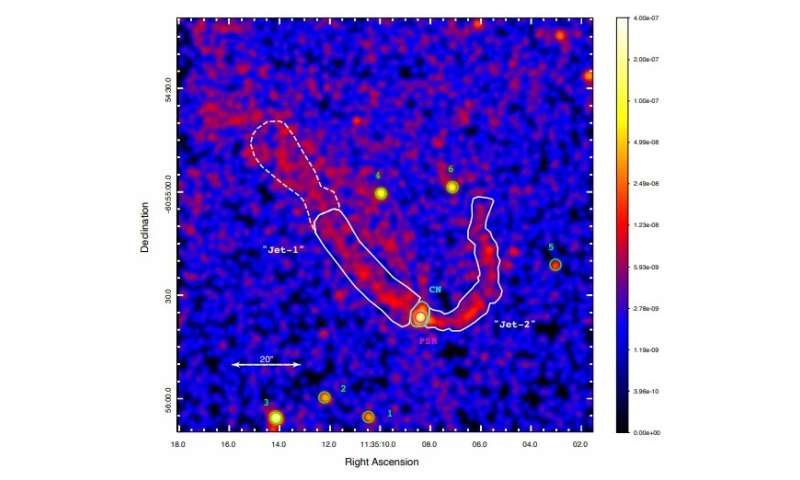
I do not like Newtonian explanations for structures that literally cover light years. My own cloud cosmology expects event horizon decay to convert matter into photonic energy with direction and information retention allowing for decay back into particles even light years away.
This is how a Galaxy throws of an excess of mass as it contracts.
In the meantime we have another eample of difficult to explain structure demading far too much early action never seen.
Observations unveil jet-like structures from the pulsar PSR J1135–6055
NOVEMBER 24, 2020 REPORT
by Tomasz Nowakowski , Phys.org
Exposure-corrected flux map of the extended emission around PSR J1135–6055 for energies in the range 0.5-7.0 keV. Credit: Pol Bordas and Xiying Zhang, 2020.
https://phys.org/news/2020-11-unveil-jet-like-pulsar-psr-j11356055.html?
Using NASA's Chandra spacecraft, astronomers from the University of Barcelona, Spain, have investigated a pulsar wind nebulae (PWN) around the pulsar PSR J1135–6055. The observations detected jet-like structures from this source. The finding is reported in a paper published November 17 on arXiv pre-print server.
PWNe are nebulae powered by the wind of a pulsar. Pulsar wind is composed of charged particles and when it collides with the pulsar's surroundings, in particular with the slowly expanding supernova ejecta, it develops a PWN. Interactions of these nebulae with interstellar medium (ISM) can produce various morphological features, including torus-like structures and bipolar jets.
Observations show that one small subclass of pulsar wind nebulae, known as supersonically moving PWNe (sPWNe) showcase unusually long X-ray outflows. The length, nearly rectilinear geometry and misaligned orientation (with respect to the pulsar proper motion) of these extended jet-like structures is puzzling, and the origin of such features remains unknown.
Now, Pol Bordas and Xiying Zhang report the finding of another interesting jet-like structure as a result of their study of an sPWN around PSR J1135–6055, a young and energetic pulsar at a distance of about 9,130 light years away from the Earth.
"In this letter, we report on the analysis of about 130 ks observations of the PWN around PSR J1135–6055 obtained with the Chandra satellite," the astronomers wrote in the paper.
The observations detected bipolar jet-like structure displaying a highly asymmetric geometry. It consists of an eastern jet-like feature, designated Jet-1, and the western one, named Jet-2. The two jets were estimated to be some 2.0 light years long each.
Jet-1, that may be composed of several extended sub-structures, appears to be more diffuse and displays a much more rectilinear structure compared to Jet-2, which has an "arc" shape. The extended emission observed from the Jet-1 is relatively wider than from the western outflow.
The astronomers assume that the morphology of Jet-2 is likely related to the pressure exerted on the outflow by the surrounding medium. They added that the morphology of the two jets is similar to that observed in the runaway pulsars like PSR J1509–5850 and Geminga.
The researchers attempt to explain the origin of the two jets in PSR J1135–6055 and offer few hypotheses, including both canonical PWN and jet formation models, as well as some alternative scenarios.
"The spectral and morphological properties of the extended structures discussed above cannot exclude alternative scenarios for the production of the jet-like structures observed in PSR J1135–6055," the authors of the paper wrote.
However, further observations of PSR J1135–6055, mainly in X-rays or at lower wavelengths, are required to get more insights into the origin of the observed outflows from this pulsar.
No comments:
Post a Comment